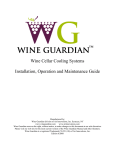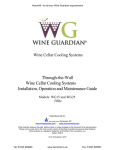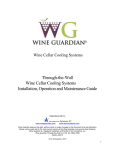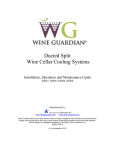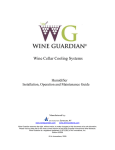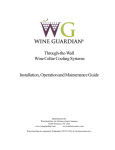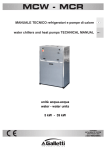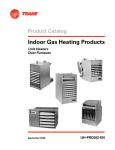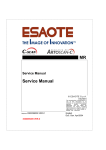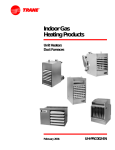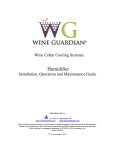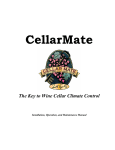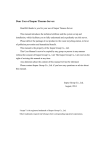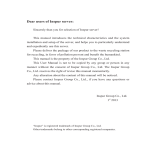Download Wine Guardian Through-the-Wall Specifications
Transcript
Wine Cellar Cooling Systems Manufactured by: Wine Guardian division of Air Innovations, Inc. Syracuse, NY www.wineguardian.com www.airinnovations.com Wine Guardian is a registered Trademark (76/551,126) of Air Innovations, Inc. Table of Contents Customer Warranty Registration ...................................................................................... 1 Introduction ........................................................................................................................ 1 Directory of Terms .............................................................................................................. 2 Receiving, Inspecting and Unpacking the Wine Guardian Unit ..................................... 3 Receiving and Inspecting the Unit ............................................................................................................... 3 Review the Packing Slip to verify: ............................................................................................................... 3 Check the unit for: ....................................................................................................................................... 3 General Description ........................................................................................................... 4 Standard Specifications ............................................................................................................................... 5 The Wine Guardian Unit Contains ........................................................................................................ 5 Accessories and Optional Equipment .......................................................................................................... 6 Heating Coils ........................................................................................................................................ 6 Water Cooled Option ............................................................................................................................ 6 Duct Collars and Flexiable Ducts .......................................................................................................... 6 Extended Compressor Warranty........................................................................................................... 6 Low Ambient Option .............................................................................................................................. 6 Condensate Pump ................................................................................................................................ 6 Humidifier and Humidistat ..................................................................................................................... 6 Overview of the Wine Guardian Unit ........................................................................................................... 8 Overview Illustration of the Wine Guardian Unit .................................................................................... 9 Refrigeration Illustration - Vapor Compression System ......................................................................... 9 Wiring Diagrams 24S025 and 24S050 ................................................................................................ 10 Wiring Diagrams 24S088 and 24S200 ................................................................................................ 11 Wine Guardian Dimensional Data ....................................................................................................... 12 Wine Guardian Specifications ............................................................................................................. 13 Safety ................................................................................................................................. 14 Safety Message Conventions .................................................................................................................... 14 Danger ............................................................................................................................................... 14 Warning .............................................................................................................................................. 14 Caution ............................................................................................................................................... 15 Lockout/Tagout Procedure ........................................................................................................................ 15 Safety Considerations ............................................................................................................................... 15 Safety Hazards .......................................................................................................................................... 16 Electrical Hazards .............................................................................................................................. 16 Electrical Shock Hazards ............................................................................................................. 16 Hot Parts Hazards .............................................................................................................................. 16 Moving Parts Hazards......................................................................................................................... 16 Equipment Safety Interlocks ...................................................................................................................... 16 Main Power Switch .................................................................................................................................... 17 Installation ........................................................................................................................ 19 Pre-installation Test ................................................................................................................................... 19 Air Flow Illustration .................................................................................................................................... 19 Planning the Installation ............................................................................................................................ 21 Addressing Items in the Planning Process .......................................................................................... 21 Performing a Pre-installation Check .................................................................................................. 21 Locating the Unit ................................................................................................................................. 22 Grilles ................................................................................................................................................. 22 Reducing Noise From the Unit ............................................................................................................ 22 Installing the Unit Outdoors ....................................................................................................................... 23 Mounting the Unit ...................................................................................................................................... 23 Floor Mounting .................................................................................................................................... 23 Wall Mounting ..................................................................................................................................... 23 Ceiling Mounting ................................................................................................................................. 24 Installing the Condensate Drain Connection ................................................................. 24 Installing the Drain Line ............................................................................................................................. 24 Priming the Drain Trap .............................................................................................................................. 25 Wiring the Unit for Power ................................................................................................ 25 Serial Plate ................................................................................................................................................ 25 Electrical Plug configuration ...................................................................................................................... 26 Installing the Thermostat and Control Wiring ................................................................ 26 Removing the Wires for Installation (if necessary) ................................................................................... 26 Reinstalling the Wires ............................................................................................................................... 27 Adding Additional Wiring ........................................................................................................................... 27 Mounting the Thermostat ................................................................................................ 27 Setting the Thermostat .............................................................................................................................. 27 Time Delays Built Into the Thermostat ....................................................................................................... 28 Location of Supply and Return Grilles ........................................................................... 28 Relocating the grill on the Wine Guardian ................................................................................................. 28 Installing the Ductwork .................................................................................................... 29 Recommended Insulated Flexible Ductwork Sizing Chart ......................................................................... 29 General Duct Recommendation ................................................................................................................ 30 Not Using Ductwork .................................................................................................................................. 30 Using Ductwork ......................................................................................................................................... 31 Typical Mounting Arrangements .................................................................................... 32 Through the Wall Mounts .......................................................................................................................... 32 Remote Mount On Floor ............................................................................................................................ 33 Ceiling Mounts .......................................................................................................................................... 33 Outside Mounts ......................................................................................................................................... 33 Duct Adapter Sizes ........................................................................................................... 34 Ducting Options ............................................................................................................... 34 Single Duct Installation .............................................................................................................................. 34 Dual Duct Installation ................................................................................................................................ 35 Inspection and Start-up Checklists ................................................................................. 36 Receiving and Inspecting .......................................................................................................................... 36 Handling and Installing .............................................................................................................................. 36 Starting-up the Unit ....................................................................................................... 36 Starting-up and Operating the Wine Guardian .............................................................. 37 Turn on the Unit ........................................................................................................................................ 37 Testing the Fan ......................................................................................................................................... 37 Running the Unit ....................................................................................................................................... 37 Cycling the Unit ......................................................................................................................................... 38 Setting the Thermostat ............................................................................................................................. 38 Regulating the Wine Cellar Temperature ................................................................................................... 38 Changing the Air Flow Direction ................................................................................................................ 38 Maintenance...................................................................................................................... 39 General ..................................................................................................................................................... 39 Cleaning the Filters ................................................................................................................................... 40 Cleaning the Condensate Drain System .................................................................................................... 40 Cleaning the Humidifier ............................................................................................................................. 40 Heating Coil Option ................................................................................................................................... 41 Low Ambient Option .................................................................................................................................. 41 Maintenance Schedule .............................................................................................................................. 41 Monthly ............................................................................................................................................... 41 Yearly .................................................................................................................................................. 41 Troubleshooting ............................................................................................................... 43 Typical Start-up Problems ......................................................................................................................... 43 Unit Does Not Start-up .............................................................................................................................. 44 Power Switch Light is Off .................................................................................................................... 44 Power Switch Light is On and the Thermostat Light is Off .................................................................. 44 Power Switch Light is On and the Thermostat Light is On .................................................................. 44 Unit is Operating and Blows Evaporator Air, but the Supply Air is Not Colder Than the Return Air from the Cellar ........................................................................................................................................................ 44 Problems Controlling Cellar Temperature .................................................................................................. 45 Cellar Temperature is Too Low (Below 510) When Unit is Running ................................................... 45 Cellar Temperature is Too Cold (Below 510) When Unit is Not Running ............................................ 45 Cellar Temperature is Too High, but Supply Air is Cold ....................................................................... 45 Problems Controlling Cellar Humidity ........................................................................................................ 46 Humidity Too Low or Supply Air is Too Cold, Without Optional Humidifier ........................................... 46 Humidity Too Low and Without Optional Humidifier ............................................................................ 46 Humidity Too Low and With Optional Humidifier ................................................................................. 46 Humidity Too High When Unit is Running But Not Cooling ................................................................. 46 Humidity Too High When Unit is Not Running ..................................................................................... 47 Humidity Too High When Unit is Running and Cooling ....................................................................... 47 Other Miscellaneous Problems ................................................................................................................. 47 Unit operates but the Power Switch light is not ON ............................................................................. 47 Unit is leaking water ............................................................................................................................ 47 Unit is Running Properly, but the Sound of Unit is Objectionable ...................................................... 47 High Pressure Switch has Shut the Unit Down .......................................................................................... 48 Instructions to Reset High Pressure Switch .............................................................................................. 48 Advanced Troubleshooting ............................................................................................. 49 Evaporator Coil is Freezing ....................................................................................................................... 49 High Pressure Switch Keeps Opening Even After Checking for Obstructions and Dirty Filters/Coils ......... 49 Unit Cycles On and Off More than 8 times/hr. ........................................................................................... 49 High Pitched or Loud Rubbing Noise, Clanking or Vibration ...................................................................... 49 Replacing the Blowers ............................................................................................................................... 49 Appendix ........................................................................................................................... 50 Warranty Procedure ......................................................................................................... 50 Wine Guardian Warranty .................................................................................................. 51 Introduction Dear Customer, Congratulations and thank you for purchasing a Wine Guardian cooling unit. We believe it to be the best wine cellar cooling unit on the market and hope you will find the same. This guide is intended to help the installer and owner of the Wine Guardian cooling system to properly install and maintain the equipment. In order to ensure a long and trouble free life, the equipment should be installed properly and have proper care and maintenance. Please read this manual carefully, especially the safety instructions, and keep it for future reference. IMPORTANT! Customer Warranty Registration PLEASE FILL OUT AND RETURN IMMEDIATELY TO REGISTER THE WARRANTY ON YOUR NEW WINE GUARDIAN AND ACCESSORIES Wine Guardian’s Consumer Protection Program Please complete and return this Product Registration Card along with copies of your original purchase receipts within ten days to enroll in Wine Guardians Consumer Protection Program. By registering your purchase, you will automatically be enrolled in our Consumer Protection Program provides you with the following: √ Product Safety Notification: registering your product allows us to contact you in the unlikely event a product safety notification is required. √ Confirmation of ownership: we keep the model number, serial number, and other information on this card in our files up to ten years. In the event of fire, flood or theft, your registration serves as your proof of purchase for insurance purposes. √ Warranty Service: filling out Product Registration Card helps you obtain efficient warranty service. 1 Directory of Terms Ambient Air – The surrounding area outside the cellar such as a room, basement, garage or outside. BTU/H – British Thermal Unit per Hour is a unit of heat measurement. For example, one ton of cooling equals 12,000 BTU/H. CFM – Cubic feet per minute. A unit of measurement for the amount of air handled by the fan. Cellar – The wine storage area being conditioned by the Wine Guardian unit. Condensate / Condensation – The water formed out of the air when it is cooled below a certain temperature (called dew point). Often referred to as “sweating” on pipes and cold surfaces. This water collects at the bottom of the evaporator or cooling coil and drains out of the unit through the drain line. Condenser (heat rejection) Section / Coil – The Condenser Section uses the compressor, condenser coil and fan to remove heat from the refrigerant to the ambient air outside the wine cellar. The word condenser refers to the condensation of the refrigerant from gas to liquid phase. Exhaust Air – The air leaving the evaporator or condenser section of the Wine Guardian unit. Evaporator (cooling) Section / Coil – The Evaporator Section uses the cooling coil and the fan to remove heat from the air inside the wine cellar to the refrigerant, cooling the air and condensing moisture out of the air. The word evaporator refers the evaporation of the refrigerant from liquid to gas phase in the coil. The Evaporator Section is connected to or inside the wine cellar. Flexible Duct – Round ducts with a steel reinforced plastic liner, a layer of insulation and an outer plastic layer used to convey the air from the unit to the cellar or ambient space. Grille or Diffuser – Inlet or outlet plates to direct the airflow or protect the inside of the unit. Heat Gain / Loss – The amount of cooling or heating expressed in BTU/H tranferred between the wine cellar and the ambient space. The Wine Guardian must offset this load. Inlet Air – The air entering the evaporator and condenser sections of the Wine Guardian unit. Recovery – The amount of cooling the unit does to return the cellar to its set point temperature after some new load is introduced, such as people or new cases of warm wine in the cellar. Return Air - The air leaving the cellar and returning to the inlet of the evaporator coil. SP – Static pressure. Unit of measurement ( inches of water column) of the pressure of the air handled by the fan. Set Point – The desired temperature or humidity set on the thermostat or humidistat. Supply Air - The air entering the cellar from the discharge of the evaporator coil. 2 Receiving, Inspecting and Unpacking the Wine Guardian Unit Receiving and Inspecting the Unit NOTE Wine Guardian units are factory assembled and tested prior to shipment. Wine Guardian units are shipped in individual cardboard boxes. √ Lift at the designated handhold locations only or fully support from underneath. A shipment may include one or more boxes containing accessories. √ Before opening the container, inspect the packing crates or boxes for obvious signs of damage or mishandling. √ Write any discrepancy or visual damage on the bill of lading before signing. √ Inspect all equipment for any sign of damage caused during transit. √ Report all visual or concealed damage to the carrier and file a claim immediately. √ Thoroughly inspect the contents for any visible damage or loose parts. IMPORTANT If this procedure is not followed, the shipping company may reject the claim and the consignee may suffer the loss. Do not return the shipment to the factory. Review the Packing Slip to verify: √ Model number √ Factory installed options √ Unit accessories If any items listed on the packing slip do not match your order information, contact the place of purchase immediately. Check the unit for: √ An electrical power cord √ A thermostat wired into the terminal strip on the unit √ A drain line coming out of the unit 3 General Description View the Overview Illustration on page 9 for details. The Wine Guardian cooling unit is a professional, USA manufactured, self-contained climate control unit designed specifically for the storage of wine at cellar temperatures. It is designed for easy installation and operation. Wine Guardian uses digital electronic controls and environmentally friendly R-134a refrigerant. The entire unit is run tested at the factory and shipped as a single package. All components are of a high quality standard commercial grade. The entire unit is approved by ETL according to UL 1995 and CSA safety standards. All wiring complies with NEC. Each unit is furnished with a sealed, UL approved power cord and plug. The Wine Guardian unit is completely self-contained and includes an integral air or water cooled condenser. The unit is functionally divided into two sections, the evaporator or cooling section and the condenser or heat rejection section. Each section contains a coil to add or remove heat and a fan to move the air through the coil and into or out of the cellar or adjacent space. The Wine Guardian unit is designed to be used either as a free blowing, through the wall unit or as a remote mount unit with external ductwork connections. Air from the cellar first enters a filter to remove any airborne dust particles and then enters the cooling coil. Air passes through the cooling coil and is cooled by the refrigerant inside the coil. This causes any excess humidity in the air to condense and be captured in the drain pan and piped outside the unit. Air then enters the fan where it is pressurized and discharged out of the unit. Optional heating coils are located between the cooling coil and the fan. These coils heat the air to prevent low temperatures in the cellar. The thermostat, located in the cellar, turns on the cooling or heating as needed to maintain its set point. It does not allow the cooling and heating to be on at the same time. The compressor and condenser sections are activated whenever the unit is cooling. The condenser fan draws air from the surrounding or ambient space either directly or through a duct. The air is first drawn through a filter to remove any airborne dust particles to keep the coil clean. Then the air flows through the condenser coil where it absorbs heat from the refrigerant in the coil. The air is finally discharged out of the unit by the condenser fan. IMPORTANT The air exhaust from the condenser fan is hot and will be 25 to 35 degrees F above the entering temperature. This may cause overheating problems in the summer months, especially with high humidity. Exhaust the hot air to the outside. In the winter, this heated air can help to heat the surrounding space. 4 Standard Specifications IMPORTANT Design and specifications are subject to change without notice The Wine Guardian Unit Contains √ A thermal expansion valve to control the flow of refrigerant into the evaporator coil √ A filter dryer to keep the refrigerant clean and free of contaminants √ A sight glass to observe the level of refrigerant √ An automatic low pressure switch to prevent low suction pressures and frost formation on the coil √ A manually reset high pressure switch on the discharge to protect the compressor from high pressures √ The unit uses only environmentally friendly refrigerant R-134a. √ A built-in condensate drain trap. No external trap is required. The Wine Guardian meets or exceeds its rated capacities for total BTU/H and CFM at design cellar conditions and external static pressures. Both the evaporator and condenser fans are capable of rated CFM against the external static pressure imposed by recommended ductwork. Both fans are motorized impeller plug fans, statically and dynamically balanced, and use permanently lubricated direct drive motors requiring no maintenance. All exterior framing of the Wine Guardian is powder coated, 0.063" gauge aluminum to prevent rust and corrosion. All coils are copper tubes with aluminum fins. The unit uses an external drain to remove excess moisture and not reintroduce it into the cellar or ambient space. Removable, multiple access doors are provided to facilitate cleaning and maintenance, duct connections, and access to components and wiring. Both the evaporator and the condenser coils have pre-filters on the inlet to prevent dust and dirt from fouling the coils, thereby reducing capacity. Each unit has at least three discharge outlets on both the evaporator and the condenser coils to facilitate custom installations. Each unit is provided with a pre-wired and tested electronic digital thermostat for remote mounting in the cellar. The thermostat has multiple control functions for the fans, cooling and heating. It has a fully automatic mode to switch between heating and cooling. Compressors are rotary, self-lubricating, permanently sealed, hermetic reciprocating type compressors with internal overload protection and capacitor start with a minimum of one year manufacturers warranty and an optional five year warranty. Compressors are mounted on rubber-inshear isolators to reduce noise and vibration. Electric power is supplied by a single factory furnished cord and plug. All external controls are 24 volt supplied from an internal transformer. The 230 volt units are capable of operating at 208 or 240 volts by changing the leads on the control transformer. See Wiring Diagrams . 5 Accessories and Optional Equipment Heating Coils An optional heating coil is built-in and requires no additional power source. The electric heating option is factory installed and includes primary and secondary over temperature protection devices per UL and NEC. Water Cooled Option A water cooled option is available that uses a tube-in-tube heat exchanger in place of the condenser coil and fan. Waste heat from the refrigerant is transferred to the water. A control value is used to regulate the flow of water to maintain head pressure. Duct Collars and Flexible Ducts Ducting for the Wine Guardian is sold in kits by size for each unit. Each kit contains two adapter collars, one 24ft. length of round flexible duct and two straps. The number of duct kits needed depends on the layout. The size of the kit depends on the model Wine Guardian selected. Follow installation instructions carefully. Poorly or incorrectly installed ducts can degrade the performance of your unit dramatically. Extended Compressor Warranty The Wine Guardian uses only the best commercially available compressors on the market. However, since the compressor is the single most expensive component in the unit, it is recommended that you purchase the extended warranty option. Low Ambient Option A factory installed Low Ambient option is available which makes the Guardian capable of exposure to low ambient temperatures. This feature controls the condenser fan operation based on head pressure and heats the oil reservoir. The Low Ambient Option (LAO) is recommended whenever the condenser section is exposed to air temperatures below 40°F. This can occur if the unit is placed in a garage or under an outdoor canopy or if the unit is located inside a heated space but the condenser air is ducted in from the outside. Condensate Pump An optional Wine Guardian automatic condensate pump is available to pump the water to a sink or outside. It requires a separate 115 volt electrical outlet. Humidifier and Humidistat Another popular option for the Wine Guardian is a humidifier. It comes with a sheet metal adapter box and a pre-wired humidistat. The humidifier is available for field installation and can be retrofitted onto an existing unit. Each humidifier is furnished with an electronic digital humidistat to control the humid- 6 ity in the cellar. The humidifier mounts directly onto the Wine Guardian unit and uses the common drain. The humidifier requires a HOT water supply and no additional external power. CAUTION CAREFULLY FOLLOW THE INSTALLATIONS INSTRUCTIONS INCLUDED WITH THE HUMIDIFIER. REFER TO THE INSTRUCTIONS CONTAINED IN THE BOX FOR THE HUMIDISTAT. 7 Overview of the Wine Guardian Unit Refer to illustrations on page 9 Cabinet – The cabinet and access doors are constructed of aluminum with a powder coated finish for corrosion protection and an attractive, maintenance free appearance. Areas in contact with cold temperatures are lined with insulation to prevent condensation. Condensing Section - Ambient air is circulated through the condenser section by a direct drive, permanently lubricated, motorized impeller blower. This section also contains the compressor and the electrical controls. If the water cooled option is purchased, a heat exchanger is used in place of the condenser coil and blower. Evaporator Section – Cellar air is circulated through the evaporator section by another blower the same as above. The large evaporator coil face area eliminates condensate carry-over, reduces air pressure drop and optimizes heat transfer. A drain pan is located directly below the coil to capture condensate and is fabricated from aluminum to prevent rust and corrosion. The electric heating coil, if ordered, is factory installed between the evaporator coil and the blower, and is complete with contactor(s) and limit controls. Electrical Controls – Most of the electrical components and controls are located in a separate area accessible through the condenser section. All wiring is in accordance with the National Electrical Code. Wires are numbered and color coded to match the wiring diagrams. Factory Tested – All Wine Guardian units are factory run-tested and checked for operational performance. Filters – Nominal 1" thick filters are provided on both the evaporator and condenser inlets to protect the coils from dust and dirt. These filters are washable and reusable. Humidity Option – The optional humidifier comes fully assembled and tested for field installation onto the Wine Guardian without any additional electrical power wiring. It automatically adds moisture into the cellar by the evaporation of water over a distribution pad. A cellar mounted digital electronic humidistat automatically controls the amount of moisture added. Internal Drain Trap - Water condensate from the evaporator coil fills the trap and forms a seal to prevent air from being drawn back through the drain tube. This allows the drain pan to drain freely. No external trap is required. Refrigerant Circuit – The factory charged circuit includes a thermal expansion valve with an external equalizer, sight glass with moisture indicator, a filter dryer, an automatic low pressure switch, and a manually reset high pressure switch. For the low ambient option, an automatic pressure switch controls the operation of the condenser blower and a heating element is added to the compressor oil reservoir. See Refrigeration Illustration on next page Supply/return grilles – Powder-coated steel single direction grilles are provided for the inlets to the evaporator and condenser sections. One grille is provided on an outlet. These are readily interchangeable with access doors to control and direct the airflow. These grilles may be used in the room on the end of the ducts in ducted systems . 8 Overview Illustration of the Wine Guardian Unit Refrigeration Illustration - Vapor Compression System 9 Wiring Diagrams 24S025 and 24S050 10 Wiring Diagrams 24S088 and 24S200 11 Safety Before installing or maintaining the Wine Guardian Unit do the following: 1) Read these instructions. 2) Keep these instructions. 3) Heed all warnings. 4) Follow all instructions. IMPORTANT The equipment described in this manual uses electricity. When using this equipment, be sure to follow the safety procedures outlined in the Wine Guardian Manual. Safety Message Conventions Safety messages contained in this manual, DANGER, WARNING, and CAUTION are bold and highlighted in red for quick identification. DANGER A Danger message indicates an imminently hazardous situation which, if not avoided, results in death or serious injury. Messages identified by the word DANGER are used sparingly and only for those situations presenting the most serious hazards. Following is a typical example of a Danger message as it could appear in the manual: DANGER HIGH VOLTAGE - RISK OF SERIOUS INJURY OR DEATH High voltages are present in the cabinets. Before opening panels turn off all power. Use the Lockout/Tagout procedure . Warning A Warning message indicates a potentially hazardous situation which, if not avoided, could result in death or serious injury. 14 Following is a typical example of a Warning message as it could appear in the manual: WARNING RISK OF PERSONAL INJURY OR DAMAGE TO EQUIPMENT Modification to the equipment may cause injury. Caution A Caution message indicates a potentially hazardous situation which, if not avoided, could result in minor or moderate injury. It may also be used to alert against unsafe practices. Following is a typical example of a Caution message as it could appear in the manual: CAUTION RISK OF PERSONAL INJURY OR DAMAGE TO EQUIPMENT Improper installation may result in the equipment malfunctioning and a safety hazard. Read all of the installation instructions before installing the Wine Guardian unit. Lockout/Tagout Procedure 1) Turn off the power switch (indicator light should be off) 2) Unplug the unit from the electrical outlet and cover the outlet to prevent accidently plugging in the unit. Safety Considerations The equipment covered by this manual is designed for safe and reliable operation when installed and operated within its designed specifications. To avoid personal injury or damage to equipment or property when installing or operating this equipment, it is essential that qualified, experienced personnel perform these functions using good judgement and safe practices. See the following cautionary statements. Installation and maintenance of this equipment is to be performed only by qualified personnel who are familiar with local codes and regulations, and are experienced with this type of equipment. 15 Safety Hazards Exposure to safety hazards is limited to maintenance personnel working in and around the unit. When performing maintenance, always use the Lockout/Tagout procedure, which is described in this chapter. Observe the maintenance safety guideline in the Wine Guardian Manual. Electrical Hazards Working on the equipment may involve exposure to dangerously high voltage. Make sure you are aware of the level of electrical hazard when working on the system. Observe all electrical warning labels on the unit. Electrical Shock Hazards All power must be disconnected prior to installation and servicing this equipment. More than one source of power may be present. Disconnect all power sources to avoid electrocution or shock injuries. Hot Parts Hazards Electric Resistance heating elements must be disconnected prior to servicing. Electric Heaters may start automatically, disconnect all power and control circuits prior to servicing the unit to avoid burns. Moving Parts Hazards The Motor and Blower must be disconnected prior to opening access panels. The motor can start automatically. Disconnect all power and control circuits prior to servicing to avoid serious injuries or possible dismemberment. The fans are free-wheeling after the power is disconnected. Allow the fans to stop completely before servicing the unit to avoid cuts or dismemberment. Rotating Fan Blades are present in the Wine Guardian unit. Sticking a hand into an exposed fan while under power could result in serious injury. Be sure to use the Lockout/Tagout procedure when working in this area or remove the power cord. Equipment Safety Interlocks There are no electrical safety lockouts installed within the unit. The power cord attached to the control box must be disconnected from the power sourcs prior to working on any part of the electrical system. 16 Main Power Switch The main power switch is located on the side of the Wine Guardian unit. (See Overview Sketch on page 10 ) It shuts off the power to the unit. Energy Type Electrical Hazard........................Electrocution, electrical burns and shock Magnitude..................120 Vac and 230 Vac, 1 phase, 60 cycles Control Method...........Disconnect power cord and On/Off Switch DANGERS • Never reach into a unit while the fan is running. • Never open an access door to a fan while the fan is running. • Disconnect the power cord switch before working on the unit. The unit may have more than one power source to disconnect. • Avoid risk of fire or electric shock. Do not expose the unit to rain or moisture. WARNINGS • Check weights to be sure that the rigging equipment can support and move the Wine Guardian unit safely. Note any specific rigging and installation instructions located in the Installation section of the Wine Guardian Manual. • All supports for the unit must be capable of safely supporting the equipment’s weight and any additional live or dead loads encountered. • All supports for the unit must be designed to meet applicable local codes and ordinances. • Do not remove access panels until fan impellers have completely stopped. Pressure developed by moving impellers can cause excessive force against the access panels. • Fan impellers continue to turn (free-wheel) after the power is shut off. 17 CAUTIONS • Clean only with a dry cloth. • Never pressurize equipment above specified test pressure. See Wine Guardian Specification Sheet • Do not use the Wine Guardian near water. • Do not block any supply or return air register or duct. Install in accordance with the instructions in the Wine Guardian Manual. • Do not defeat the safety purpose of the polarized or grounding type plug. A polarized plug has two blades with one wider than the other. A grounding type plug has two blades and a third grounding prong. The wide blade or the third prong are provided for your safety. If the provided plug does not fit into your outlet, consult an electrician for replacement of the obsolete outlet. • Protect the power cord from being walked on or pinched, particularly at the outlet plugs, convenience receptacles, and the point where it exits the unit. • Only use attachments/accessories specified by the manufacturer. • Always operate this equipment from a 120 VAC or 230 VAC, 1 phase 60 Hz power sources only. • Always ground the outlet to provide adequate protection against voltage surges and built-up static charges (see Section 810 of the National Electric Code). • Refer all servicing to qualified service personnel. Servicing is required when the unit has been damaged in any way, such as: √ power supply cord or plug is damaged √ liquid has been spilled or objects have fallen into the unit √ the unit has been exposed to rain or moisture √ the unit does not operate normally √ the unit has been dropped. 18 Installation CAUTION SHARP EDGES RISK OF SERIOUS INJURY Sharp edges are present inside the Wine Guardian Unit. Pre-installation Test Test the unit before installing it to check for non-visible shipping damage. To test the unit: √ Set the unit on the floor or a sturdy level surface √ Plug in the unit √ Turn on the rocker switch. The switch light comes on. This indicates the unit has power √ The built in timer prevents short cycling and keeps the unit from turning on right away. To override the timer, open the thermostat cover and simultaneously press the fan and up arrow buttons. The unit comes on and runs as long as the temperature of the space is above the thermostat set point. After several minutes, cold air comes out of the unit from the evaporator section side and hot air comes from the condenser section. Listen for any unusual noise or vibration. (See Air Flow Illustration below) Air Flow Illustration 19 WARNING RISK OF PERSONAL INJURY OR DAMAGE TO EQUIPMENT Modification to the equipment may cause injury or damage to the equipment. DANGER √ This equipment is heavy. Place the unit on the floor or on a level and stable surface that can support the full weight of the unit. √ Do not modify the equipment, it may cause damage to the equipment and voids the warranty. √ Never place anything on top of the unit. √ Never block or cover any of the openings or outlets of the unit. √ Never allow anything to rest on or roll over the power cord. √ Never place the unit where the power cord is subject to wear or abuse. √ Do not use extension cords. √ Never overload wall outlets. √ Do not remove or open any access door or cover unless the unit is turned off and the power cord is unplugged. √ Use only dedicated power outlet boxes of the correct capacity and configuration for the unit model. CAUTION RISK OF PERSONAL INJURY OR DAMAGE TO EQUIPMENT Improper installation may result in the equipment malfunctioning and a safety hazard. Read all of the installation instructions before installing the Wine Guardian unit. 20 Planning the Installation Addressing Items in the Planning Process √ Where to locate the unit? Should it be built into the wall or mounted remote and ducted into the cellar. √ How to mount the unit? √ Decide where to locate the supply and return grilles in the room to achieve the temperature gradient and circulation preferred. √ Locate the electrical power outlet close to the unit. Do not use an extension cord! √ Does the condenser heat exhaust need to be ducted away? √ Where to locate the thermostat? √ Where to run the drain line? √ Are all the parts here to complete the installation? Performing a Pre-installation Check √ Check for the proper installation of the electrical plug configuration √ Check for the properly sized breaker √ Is the cellar built with adequate insulation and vapor barriers. See the Wine Cellar Design Guide at the Wine Guardian’s web site www.wineguardian.com for more information. √ Are ducts installed above the ceiling or in accessible places properly sized before being covered. √ Is enough space available around the unit for service and repair. 21 Locating the Unit Wine Guardian units are typically installed indoors located near the cellar to minimize the duct runs. Each unit is provided with one entering or return air inlet and three possible supply air outlets for each of the evaporator and condenser sections. A maximum cumulative total length for both supply and return ducts (including bends) of 25’ is recommended. If longer runs are needed use more than one supply opening to reduce the airflow in each duct by ½. See Recommended Flexible Ductwork Sizing Chart on page 30. Provide a 3’ clearance around the unit for removal of grilles or ductwork, access to filters and unit maintenance. If the humidifier is used, provide access space in front of it for service. Grilles Each of the inlets and one evaporator outlet and one condenser outlet come from the factory with grilles over the openings. The grilles are removable. Remove the necessary grilles for installing ductwork between the unit and the cellar. If desired, use the grilles as wall grilles inside the cellar. The return air, or inlet, to the unit must connect to the return air outlet from the cellar. Any of the three supply air outlets on the unit can be used for the ductwork to the supply grille inside the cellar. The factory installed outlet grille can be relocated to any of the other two openings. The procedures below apply to both the evaporator and the condenser sections. In most cases, no ducts are installed on the condenser section because the unit is located in a mechanical or storage type space. If exhaust heat is undesirable use the grilles to install ductwork to move the heat outdoors or to another space. Also, use ductwork to direct condenser air noise away from occupants. Reducing Noise From the Unit Consider noise when locating the unit close to the cellar or an adjacent occupied space. A piece of 1" or 2" dense rubber or styrofoam with foil face in between the unit and the wall absorbs and reduces the noise from the unit. For air noise use better grilles or block the noise with a solid piece of wood or styrofoam. Sound usually travels as a line of sight. Sound is reduced when it turns a corner, such as, passing through a bend in ductwork. If the unit is supported from a wall or joist, using a rubber pad under the unit will reduce vibration transmission. 22 Installing the Unit Outdoors The Wine Guardian is NOT designed nor approved for direct outdoor installation. If it is located outdoors, it MUST be protected with a rain proof enclosure. • Mount it above the ground on a solid, waterproof base to protect the unit from ground water. • Do not locate it where grass clippings or leaves can blow into the unit. • Keep the area around the unit clean and free of debris. • Protect from damage when the unit is located in a garage or unheated shed. In both cases, the unit MUST have the low ambient controls built into the unit. • Double insulating ducts with exterior grade insulation is recommended to keep the ducts dry and effective. Wine Guardian suggests installing one sized flexible duct inside the next larger size duct where ductwork is exposed. • Allow enough space at both ends of the unit to remove the grilles or ductwork and allow access to the filters. Mounting the Unit CAUTION RISK OF PERSONAL INJURY OR DAMAGE TO EQUIPMENT Check supporting structure for load bearing capacity to support the Wine Guardian. All supports must be designed to meet applicable local codes and ordinances. If in doubt, consult a qualified architect, engineer or contractor. Note Review the mounting illustrations on pages 32 and 33 before mounting the unit. Floor Mounting Mount the Wine Guardian on the floor but elevate it on a 2" x 4" frame with a plywood surface to keep it away from water. Allow adequate space for the external drain. Wall Mounting If the unit is mount through the wall, adequately support it on both sides of the wall. Use floor or knee braces to transfer the load of the unit to the floor or wall. 23 Ceiling Mounting Construct a structurally sound, level platform to place the unit on when hanging it from the ceiling joists. The Wine Guardian is NOT designed to be suspended from the top of the unit. Place the unit on a platform to ensure that the unit is supported on all for corners. Leave adequate space on the top of the unit to remove the access doors for service. In all cases the unit must be level to within +/- 1/4" end to end and +/- 1/8" side to side for proper operation. Locate the unit as close to the wine cellar as possible to reduce the length of the duct runs. If possible, use short and straight ducting on all ductwork. The addition of 1/4” thick rubber pads helps prevent the transmission of vibration and noise. Installing the Condensate Drain Connection The Wine Guardian unit provides dehumidification for the inside of the wine cellar. It cools the air down to the dew point corresponding to the temperature set point of the thermostat. If the vapor barrier of the wine cellar is poorly constructed or excess moisture is in the basement, the unit has to remove excessive amounts of moisture from the wine cellar. The moisture appears in the condensate drain of the unit. Note If moisture becomes excessive, install a room type dehumidifier to dehumidify the basement so as to not overload your Wine Guardian. Installing the Drain Line √ The drain line must extend from the unit to an external drain or disposal site. Do not use drain tubing any smaller than 1/2” ID on the unit. √ Splice the drain extension onto the drain outlet with a short piece of 1/2” copper tubing and secure with clamps √ If no floor drain is available, use a bucket. Do not extend the drain below the rim of the bucket. Empty the bucket periodically. The Guardian Unit is provided with a built-in drain trap. The drain trap creates a water seal to prevent air from backing up into the drain pan and causing the drain pan to overflow. Do not create secondary traps in the external drainline. Allow enough height for the drain line to function properly. If draining into a nearby sink, the unit must be elevated higher than the rim of the sink in order for the water to drain by gravity. Install with a ¼” per linear foot of pitch. Do not tie the condensate drain line directly into the sanitary sewer system. See Accessories and Optional Equipment section for information about the Condensate Pump. 24 Priming the Drain Trap The internal drain trap primes itself automatically once the unit has run for a period of time and after the unit cycles off. This is confirmed by water dripping from the drain. Wiring the Unit for Power DANGER ELECTRICAL SHOCK HAZARD RISK OF SERIOUS INJURY OR DEATH The electrical outlet and wiring installation must meet the national and local building codes. DO: √ Match the electrical outlet to the plug provided on the Wine Guardian. √ Provide dedicated circuit and wiring for the unit √ Provide a weatherproof plug for units mounted outside √ Match the wiring and breaker size to the rated load as shown on the serial plate and in this guide. See sample Serial Plate illustration below. Serial Plate 25 DO NOT: √ DO NOT MODIFY THE PLUGS IN ANY WAY! √ Do not use extension cords. IMPORTANT The electrical power supply must be either 115 volt or 230 volt AC 1 phase 60 cycle, depending on the model of the unit, and cannot vary more than +/- 4% or damage may occur to the unit. Plug the unit into the wall outlet. Gently pull on the plug to make sure it is tight. Electrical Plug Configuration Installing the Thermostat and Control Wiring Each Wine Guardian unit comes with a thermostat and 25’ of wiring. It is wired at the factory for testing prior to shipment. See start-up instructions in the thermostat guide for installation and operation of the thermostat. Note Keep the thermostat guide in a folder along with the Wine Guardian Manual for future reference. Removing the Wires for Installation (if necessary) 1) Note the color coding of the wires before removing 2) Using the proper screwdriver, loosen the screws and pull the wire free. 26 Reinstalling the Wires 1) Realign color coded wires 2) Wrap each wire around the screw and tighten the screw. Adding Additional Wiring √ Splice onto the factory furnished wire √ Match the wire colors for continuity √ Insulate the splice with electrical tape on each wire CAUTION RISK OF DAMAGE TO EQUIPMENT Misconnected thermostat wiring results in improper operation and/or causes damage to the unit and thermostat. Check each colored wire to its proper color coded slot on the terminal strip and check that the wires are tight. Mounting the Thermostat Each thermostat comes with its own unique manufacturers Installation and Operating Instructions. Use the instructions on how to set and operate the thermostat and to understand how to install the thermostat. Mount the thermostat on a solid surface away from doors, corners, air outlets, drafts or heat generating equipment. Do not mount the thermostat directly on an outside wall or wall adjacent to a boiler room. Use a piece of foam insulation behind the thermostat to insulate it from a hot or cold surface. The recommended height is 4’ to 5’ above the floor. Setting the Thermostat The thermostat has been wired and set up in the factory for testing. It is an electronic digital thermostat for one (1) stage cooling and one (1) stage heating. No additional adjustments should be necessary except adjusting the cellar temperature to your preference. Note that the heating and cooling cannot be set any closer than 3 deg F apart to prevent short cycling. If additional adjustments or changes are necessary, please refer to the thermostat manufacturer literature included in the box for detailed installation and operating instructions. 27 Note installation setup number and setting changed from the factory settings. Setup Number 3 - Changed to 1 Setup Number 5 - Changed to 9 Setup Number 9 - Changed to 5 Setup Number 12 - Changed to 1 Wiring diagram Fig .6 applies (Conventional 1 heating/1 cooling system with one transformer) The thermostat can receive a battery to light the panel in case of a power failure. It serves no other purpose and is not required for operation or restart after a power failure. Time Delays Built Into the Thermostat Pay attention to the various time delays built into the thermostat as explained in the Thermostat Installation and Operating Instructions. The time delays are built in to protect the Wine Guardian and its components from damage due to short cycling. Note Any time the “cool on” indicator is flashing the unit is waiting for the timer in order to start. Location of Supply and Return Grilles Locate the supply and return grilles inside the cellar to create an airflow pattern that maximizes air circulation in the room. Avoid short circulating of the air. Do Not: • install the return air grilles directly on the floor as the grilles will collect dust from the floor. • locate the supply or return air grille where it is blocked by bottles, boxes or cases. • locate the supply air grille where it blows directly on the thermostat. Relocating a Grille on the Wine Guardian 1) Remove the fasteners from the grille 2) Remove the fasteners from the access door panel to be replaced by the grille 3) Relocate the outlet grille to its new location and secure in place using its fasteners 4) Replace the access door panel where grille was located. 28 Installing the Ductwork Use ductwork to connect the unit to the supply and return outlets in the wine cellar. Use only insulated ductwork to minimize cooling loses, prevent sweating, and to reduce noise. Use ductwork on the condenser section to redirect or absorb sound, to bring in outside air to the unit inlet, and/or to exhaust the hot air out of the ambient space. NOTE Do not exceed a total of 25’ for each length of ductwork run. Recommended Insulated Flexible Ductwork Sizing Chart Evaporator (cooling) Coil Model # Condenser (heat rejection) Coil Inlet (Return Air) Outlet (supply air) Single Double Inlet Outlet Single Double 025 8” 8” 6” 8” 8” 6” 050 10” 10” 6” 10” 10” 6” 088 10” 10” 8” 10” 10” 8“ 200 12” 12 “ 10” 12” 12” 10” Notes: 1. The above referenced sizes are internal diameter in inches. 2. If a single supply is used out of the unit but then splits into two (2) ducts, the above size recommended for double is used after the split. CAUTION RISK OF DAMAGE TO EQUIPMENT Avoid crimping the flexible ducts. This chokes down the inside area and reduces the airflow causing the unit to operate erratically. Be sure all ducts and surface in contact with the airflow are Insulated and have a vapor barrier on the outside surface. 29 Uninsulated ducts and surfaces cause bare exposed metal surfaces to sweat, further degradation of the insulation and a loss of equipment cooling capacity. General Duct Recommendation √ Support the flexible duct often to prevent sags or bends. √ Stretch the duct to make for a smoother interior for less air resistance. √ For 90° bend insert a metal elbow inside the flexible duct to avoid crimping. √ Do not squeeze or reduce the inside diameter of the ducts. This restricts the airflow. √ Use short and straight ductwork. √ Review the configuration schematic on the Overview Sketch on page 9 for information about which panels are available for duct connections and service. √ Remove the panels or grilles from the openings to connect the ductwork. √ Check that all the fan blades move freely. √ Check for loose foreign objects in any of the air paths. √ Connect the round flexible ducts to the Wine Guardian using the duct collars provided with the duct accessory kit. √ Pull the outer plastic wrapping and insulation away from the end of the duct to expose the reinforced inside duct liner. √ Use tie straps of clamp around the inside liner to fasten the duct collar. Do not clamp around the outside insulation. It compresses and loosens over time. √ Secure the duct collar to the unit using the screws provided. Be careful not to damage or bend the gasket. Not Using Ductwork √ The supply and return grilles stay on the unit if no ductwork is used. √ The supply and exhaust grilles may be relocated to any of three openings. (Refer to the manufacturers installation instructions located in the box of flexible ductwork). 30 Using Ductwork Cold Air to/from Wine Cellar √ Remove supply air grille or access door panels to install ductwork between the Wine Guardian unit and the cellar. √ Connect the supply air ductwork from the cellar to the Supply air outlets at the Wine Guardian Unit. √ Connect the return air ductwork from the cellar to the return air inlet at the Wine Guardian Unit. Warm Air to/from Condenser √ Connect ductwork on the condenser to direct heat and the air noise away from occupants. √ Connect ductwork to another space within the basement, a building or to the outdoors if the heat being exhausted is undesirable. 31 Typical Mounting Arrangements The following illustrations are suggested mounting arrangements. These illustrations are not intented to be complete and detailed installation drawings. For questions or help regarding installation, call customer service at 800-825-3268 Ext. 7434 or 315-452-7434, fax 315-4527420 or email ([email protected]) us a sketch of the proposed area where the unit is to be installed. Through the Wall Mounts Through-wall Inside Flush Mount Through-wall Middle Mount (No Ductwork) Through-wall Outside Flush Mount Square & Round ducts used for illustration only Provide access to service unit 32 Remote Mount On Floor Condenser inlet and exhaust - to outsite Ceiling Mounts Ceiling Mount Through-wall Ceiling Mount with Dual Supply Outside Mounts Outside Through-wall Mount Outside Remote Mount 33 Inspection and Start-up Checklists Receiving and Inspecting Unit received undamaged Unit received complete as ordered including accessories Handling and Installing Unit mounted on solid level surface Sufficient space allowed for access to unit and accessories Proper electrical service provided Hot water provided to humidifier Drain lines and trap installed properly Ductwork, fittings and grilles installed properly All cold duct surfaces insulated Low ambient control included if freezing condition present No obstructions to air flow to condenser Starting-up the Unit General visual inspection looks good All wiring connections checked All ducts, grilles and panels in place Start unit Check ducts and connections for air leaks Balance air distribution Confirm condenser airflow is unrestricted Verify cooling and heating operation Check for excessive noise or vibration 36 Starting-up and Operating the Wine Guardian Now that the installation is complete, it’s time to start the unit up. Check to make sure all ductwork and electrical connections are secure. Replace all panels which were removed during installation. Check that all of the openings in the unit are covered with either a blank panel, a ductwork connection or a grille. CAUTION Rick of personal injury. Cover all openings of the unit to prevent a hand or finger from access inside the unit. Turn on the Unit Plug in the unit. Turn-on the rocker switch on the side of the unit. The rocker switch lights up to indicate power to the unit. The unit may not come on right away due to the timer built into the circuiting to prevent short-cycling. Refer to the thermostat instructions and set the thermostat on AUTO and 55° F. Testing the Fan Push the FAN button on the thermostat to switch from AUTO to FAN as indicated on the display screen. • FAN means the fan runs continuously and indicates that the power is on and the control circuit is energized and operating. • AUTO means the fan runs only when the thermostat is calling for cooling, heating, or the optional humidistat is calling for humidification. Running the Unit √ Check unit to confirm the compressor is running, such as the hum of the compressor or cool air leaving the unit. √ Check for any unusual noise or vibration, such as clanking or rubbing. Initially, the unit may run continuously for several hours, up to a day or more, while it lowers the cellar temperature. Once the unit reaches the set point temperature, it shuts off and starts to cycle on and off as it continues to lower the bottle temperature to the set point. The cellar air reaches set point before the bottles. If the cellar temperature started at 750F, the supply air temperature discharged from the unit will probably be 15 to 200F colder. As the cellar temperature decrease to 550F, the supply temperature differential decreases 8 to 120F colder. 37 Cycling the Unit The fans continue to free-wheel for several minutes when the unit cycles off. This is normal. If the unit is furnished with a low ambient control, the condenser fan also cycles on and off during cooling. This maintains the head pressure on the compressor under low ambient conditions, and is normal. The bottom of the compressor stays warm even when the unit is off to keep the lubricating oil warm and separated from the refrigerant. Setting the Thermostat Normal settings are between 54 and 58°F. If the optional heating coil is furnished, enter a separate temperature setting to maintain the lower setting. To prevent the unit from short cycling, the setting between heating and cooling cannot be closer than 3°F. Regulating the Wine Cellar Temperature Wine cellars have a natural temperature gradient of 5 to 100 between floor and ceiling. To increase or decrease the temperature in various zones, change the air flow patterns. To keep the entire wine cellar at the same temperature, set the thermostat to run the supply fan continuously and not just when the cooling is operating. Set Fan switch to ON instead of AUTO. NOTE To monitor the Cellar Temperature, place thermometers in various locations in the cellar to monitor the temperature zones. Change the temperature in various zones by shifting the air flow patterns. Changing the Air Flow Direction The grilles furnished with Wine Guardian are single directional. Rotate the grilles to change the direction of the air flow. When using multiple supply ductwork balance the air flow between the ductwork. If too much air flows though one duct but not enough air flows from the other duct, install a damper or other restriction into the duct with too much air. That will force more air to flow out the other duct. 38 Maintenance General WARNING BEFORE PERFORMING MAINTENANCE ON THE UNIT, READ AND UNDERSTAND THE SAFETY INFORMATION CONTAINED WITHIN THE SAFETY CHAPTER OF THE WINE GUARDIAN MANUAL. DANGER HIGH VOLTAGE - RISK OF SERIOUS INJURY OR DEATH High voltages are present in the cabinets. Turn off all power. Use the Lockout/ Tagout procedure before opening panels. CAUTION SHARP EDGES RISK OF SEROUS INJURY Sharp edges are present on the fan wheels, housing, fins and coils. Maintenance on Wine Guardian units requires working with high voltage and sheet metal with possible sharp edges. Only qualified personnel should perform maintenance. Some tasks require knowledge of mechanical and electrical methods. Make sure you are familiar with all hazards, general safety related procedures, and safety labels on the unit. CAUTION EXPOSURE TO MICROBIAL GROWTH (MOLD) CAN CAUSE SERIOUS HEALTH PROBLEMS Standing water in drain pans promote microbial growth (mold) that cause unpleasant odors and serious health-related indoor air quality problems. If mold is found, remove it immediately and sanitize that portion of the unit. The Wine Guardian is designed for minimum maintenance. The refrigerant system is hermetically sealed and requires no maintenance. The fans are permanently lubricated and require no maintenance. Some maintenance to the unit may be required due to dust or dirt in the air stream. 39 Cleaning the Filters The evaporator and condenser coils are provided with reusable, washable air filters. The filters protect the coils from becoming coated or plugged by dust. Frequency of cleaning the filters is based on the amount of dust or dirt generated in the cellar or basement. 1. Remove the grille or duct collar on the inlet end of the unit 2. Remove the filter covering the face the coil 3. Wash it under warm water 4. Shake off excess water 5. Inspect and clean the face of the coil CAUTION SHARP EDGES RISK OF SERIOUS INJURY Sharp edges are present on the fins and coils. 6. Reinstall the filter. 7. Replace the grille or duct collar Cleaning the Condensate Drain System The condensate drain system traps dust and dirt. Clean the drain system once a year. 1. Shut off the rocker switch and unplug the unit 2. Remove the grille or duct on the evaporator inlet 3. Remove the filter and inspect the drain pan under the coil 4. If drain pan appears soiled, pour some hot water mixed with liquid bleach (diluted solution) along the length of the pan to flush the dirt down the drain tube 5. Continue this treatment until the drain appears clean and free of dirt 6. Reinstall filter and grille or duct collar 7. Plug in the unit and restart Cleaning the Humidifier (optional) If the unit was furnished with a humidifier it requires periodic maintenance. Follow the instructions in the humidifier guide. 40 Heating Coil Option It is located between the evaporator coil and blower inside the transition duct. It contains the heating element and high temperature limit switches. The heating coil is wired to work in conjunction with the thermostat. Since the thermostat prevents the heating and cooling circuits from being energized at the same time, no additional power wiring is needed. We do recommend using the auto mode on the thermostat so it can switch from heating to cooling automatically. If using either the heat or cool only mode, the thermostat will not switch automatically. No additional maintenance is required for the heating coil. To test the heating coil operation, set the thermostat on heat and set the temperature above the cellar temperature. The supply air temperature should rise above the return air temperature by an amount shown in the specifications. Low Ambient Option The purpose of the Low Ambient Option is to protect the compressor and refrigerant system. It has two distinct components, a crankcase heater to keep the oil in the compressor warm and prevent slugging on system start-up and a head pressure control to cycle the condenswer fan on and off automatically to maintain system head pressure. To confirm that the system is working, feel the bottom of the heater when the compressor unit has cycled off. When the unit starts, the condenser fan does not start at the same time as the compressor. The condenser fan starts after the head pressure has built up. As the unit is running the condenser fan cycles off and on while it holds the head pressure within a fixed range. The amount of cycling (frequency and duration) depends on the air temperature. The colder the air, the more frequenct the cycling and with a longer duration. Maintenance Schedule Monthly (or quarterly depending on experience with individual cellar) √ Check filter and drain trap – clean if needed √ Check for noise or vibration √ Check for short-cycling of the unit - a turning on and off of the compressor unit more than 8 times/hour. Yearly (in addition to monthly) √ Replace filters if worn or plugged beyond cleaning √ Check evaporator and condenser coils for dirt – use a vacuum with a brush attachment to clean the coils 41 √ Clean condensate pan under the evaporator coil by flushing. Be careful to keep the drain pans clear of any and all debris. √ Inspect cabinet for corrosion or rusting – clean and paint √ Inspect for dirt buildup on or inside the unit. Clean unit by vacuuming or wiping it down. √ Check for loose insulation, fasteners, gaskets or connections √ Check the wiring connections and integrity of cords √ Examine ducts for any cracks or breach √ Check fan and solenoid on humidifier √ Replace humidifier pad (if used) 42 Troubleshooting WARNING BEFORE PROCEEDING, READ AND UNDERSTAND THE SAFETY INFORMATION CONTAINED IN THE SAFETY SECTION OF THE WINE GUARDIAN MANUAL. IMPORTANT This section is intended as a diagnostic aid only. For detailed repair or parts replacement procedures, contact a qualified service company. Check the following table for some solutions before calling a service technician. Typical Start-up Problems Possible Cause Loose, improper or defective thermostat or humidistat wiring Solution Check power, and thermostat or humidistat wiring Incorrect thermostat or humidistat (optional) settings. Check the thermostat and optional humidistat setup for the application. Read the thermostat troubleshoot guideline in the Thermostat Installation and Operating Instructions. Changed settings on the thermostat A common problem is not waiting long enough for the internal timers to complete their timed delay. These timers can be manually overridden. Follow the manufacture’s thermostat instructions. 43 Unit Does Not Start-up Power Switch Light is Off Possible Cause Solution Switch not on Turn on switch No power to outlet Check circuit breaker and wiring Unit not plugged in Plug in the unit Power Switch Light is On and the Thermostat Light is Off Possible Cause No power to thermostat Solution Check wiring for loose, broken or frayed connections Check transformer for 24v output to thermostat Power Switch Light is On and the Thermostat Light is On Possible Cause Solution Thermostat is not setup properly Check thermostat setup in the guide. Press fan ON switch to check evaporator fan only Unit is Operating and Blows Evaporator Air, but the Supply Air is Not Colder Than the Return Air from the Cellar 44 Possible Cause Solution Thermostat not setup properly Check thermostat setup in the manufacture’s thermostat guide Compressor not operating High pressure switch open (button up) (see below) Condenser airflow is blocked Remove blockage Clean filter and coil (if needed) Head Pressure (HP) switch is open Reset HP switch See reset instructions on page 50 Problems Controlling Cellar Temperature Problems are occurring even though the unit seems to be fully operational – evaporator fan blows air into the cellar and compressor and condenser fan runs. Cellar Temperature is Too Low (Below 510) When Unit is Running Possible Cause Solution Thermostat set too low on cooling Reset thermostat to higher cooling temperature Heating coil (optional) not operating Check for temperature rise across coil Thermostat set too low on heating Reset thermostat to higher heating temperature Thermostat not controlling temperature Wiring integrity compromised (shorted), replace wiring Cellar Temperature is Too Cold (Below 510) When Unit is Not Running Possible Cause Solution Too much heat loss to adjacent spaces Increase insulation around the ductwork and doorways Add heater Cellar Temperature is Too High, but Supply Air is Cold Possible Cause Solution Not enough evaporator airflow Remove blockage in supply or return ductwork Check and clean filter and coil Coil frozen – shut-off unit for two hours Cellar loads are too high Install additional insulation Replace with larger sized unit 45 Problems Controlling Cellar Humidity Humidity Too Low or Supply Air is Too Cold, Without Optional Humidifier Possible Cause Solution Not enough evaporator airflow Remove blockage in supply or return ductwork Check and clean filter and coil Coil frozen – shut-off unit for two hours Defective Thermal Expansion Valve If under warranty call for service If not under warranty call a refrigeration technician Humidity Too Low and Without Optional Humidifier Possible Cause Solution No moisture being added to cellar Add Wine Guardian humidifier or a room humidifier Humidity Too Low and With Optional Humidifier Possible Cause Solution Humidifier not operating Check wiring for loose, broken or frayed connections Check humidistat setup Check for water flow & solenoid valve operation Check damper operation Humidifier operating Check for water being hot Check drip pad – replace if scaled No vapor barrier around cellar Humidity Too High When Unit is Running But Not Cooling Possible Cause Solution Compressor not operating Check and reset high limit switch Clear blockage of condenser airflow Reduce temperature or draw condenser air from another space Ambient temperature is too high 46 Humidity Too High When Unit is Not Running Possible Cause Solution Unit needs to run to dehumidify Run unit. Seal openings around doors (gasket and sweep) Humidity Too High When Unit is Running and Cooling Possible Cause Solution Too much moisture in cellar Poor vapor barrier installation Humidifier malfunction refer to the Humidifier instructions. Add dehumidifier to surrounding space Other Miscellaneous Problems Unit operates but the Power Switch light is not ON Possible Cause Solution Bulb is burned out Replace bulb Unit is leaking water Possible Cause Solution Trap plugged Clean Trap Condensate pan plugged Remove blockage and clean Unit not level Level with shims Unit is Running Properly, but the Sound of Unit is Objectionable Possible Cause Solution Noise is from airflow Redirect airflow Add baffles Add insulated ductwork Noise is from unit Add sound baffle between unit and occupied space 47 High Pressure Switch has Shut the Unit Down Every Wine Guardian unit has a manual reset high pressure switch in the refrigeration system. This switch shuts the compressor and condenser down if the head pressure in the system is too high. It is intended to protect the compressor. Restricted airflow through the condenser is the most common reason for the pressure to become too high. This can be caused by dust covering the filter or an obstruction blocking the airflow in the duct or grille. Possible Cause Head Pressure in unit is too high because an obstruction is restricting air flow through Solution Remove the obstruction in the duct or grille or clean the filter. Then restart the unit after resetting the using the high pressure switch. Instructions to Reset High Pressure Switch √ Remove the access panel, grille or duct collar at the condenser opening labeled “High Press. Manual Reset Switch -----> Remove panel or grille to access” √ Locate the high pressure switch near the compressor (a cylindrical device piped into the refrigeration system with two wires and a red button on the top). √ Push in the button until it locks into position √ Push the rocker switch to restart the unit 48 Advanced Troubleshooting IMPORTANT THIS SECTION IS INTENDED FOR QUALIFIED REFRIGERATION SERVICE TECHNICIANS ONLY. THE TECHNICIAN SHOULD REPEAT ALL OF THE PREVIOUS TROUBLESHOOTING STEPS BEFORE TAKING ACTION ON THESE MORE TECHNICAL SOLUTIONS. Evaporator Coil is Freezing Possible Cause Solution Charge too low Check sight glass Check for leaks Add refrigerant TXV malfunctioning Repair or replace High Pressure Switch Keeps Tripping Even After Checking for Obstructions and Dirty Filters/Coils Possible Cause Solution Condenser fan not operating Repair or replace Defective switch Replace Unit Cycles On and Off More than 8 times/hr. Possible Cause Solution Thermostat malfunctioning Check the thermostat guide for thermostat information Low suction pressure Check low pressure switch Check pressure and adjust superheat High Pitched or Loud Rubbing Noise, Clanking or Vibration Possible Cause Solution Fans loose or malfunctioning Repair or replace Excessive compressor vibration Replace TXV malfunctioning Repair or replace Replacing the Blowers When replacing the fan or motor, replace the fan and motor as a unit. Do not remove the motor from the impeller wheel. 49 Appendix Warranty Procedure The Wine Guardian unit serial number is noted on all packing lists and bills of lading and, along with the shipping date, is kept on file at Wine Guardian for warranty purposes. All corresponence regarding warranty must include the model number and serial number of the unit involved. Note that the warranty is null and void if the serial number on the unit or compressor is altered, removed or defaced. All inquires or correspondence regarding warranty should be handled in accordance with the “Warranty” and directed to: Wine Guardian 7000 Performance Drive North Syracuse, New York 13212 Attn: Service Department (800) 825-3268 Phone (315) 452-7420 Fax This procedure includes but is not limited to: 50 √ Obtaining authorization from Wine Guardian prior to incurring any charges for repair or replacement under warranty. √ Returning prepaid within 30 days any and all defective parts. Wine Guardian Warranty GENERAL Wine Guardian warrants, to the original buyer, its goods and all parts thereof to be free from defects in material and workmanship for fifteen (15) months from the date of invoicing assuming NORMAL USE AND SERVICE. LIABILITY Wine Guardian liability shall be limited to the repair or replacement (at its option) of any part, which, at our sole discretion, is determined to be defective. The purchaser shall pay all transportation costs. Additionally, if a malfunction occurs within six (6) months from the date of invoice, Wine Guardian will reimburse the reasonable cost of labor required for the repair or replacement provided authorization is obtained from one of our authorized representatives prior to incurring any labor charges. LIMITATIONS OF LIABILITY THESE WARRANTIES ARE MADE IN LIEU OF ALL OTHER WARRANTIES EXPRESSED OR IMPLIED, INCLUDING ANY IMPLIED WARRANTY OF MERCHANTABILITY OR FITNESS FOR A PARTICULAR PURPOSE AND IN LIEU OF ANY OTHER OBLIGATION OR LIABILITY, INCLUDING LIABILITY FOR ANY INCIDENTAL OR CONSEQUENTIAL DAMAGES. Wine Guardian will not be responsible for any costs or liabilities whatsoever resulting from improper installation or service of its equipment. In the event that Wine Guardian or its distributors are found liable for damage based on any defect or nonconformity in the products, their total liability for each defective product shall not exceed the purchase price of such defective product. No person or representative is authorized to change these warranties or assume any other obligations or liabilities for Wine Guardian in connection with the sale of its systems. INDEMNIFICATION Purchaser agrees to indemnify, hold harmless and defend seller and its officers, directors, agents and employees from and against any and all claims, liabilities, costs and expenses arising out of or related to Purchaser’s use of the goods, or in any way involving injury to person or property or accident occasioned by the goods sold by Wine Guardian to Purchaser. FOREIGN GOVERNMENT AND INDIAN NATIONS If Purchaser is a foreign government or an Indian nation, Purchaser hereby expressly waives its defense of sovereign immunity in the event of a dispute between Purchaser and Wine Guardian regarding this invoice and Purchaser expressly acquiesces to the jurisdiction of the federal and state courts of the United States. SEVERABILITY If one or more of the provisions contained in this contract shall for any reason be held to be invalid, illegal or unenforceable in any respect, such invalidity, illegality or unenforceability shall not affect any other provision of this contract, but this contract shall be construed as if such invalid, illegal or unenforceable provision had never been contained. ADDITIONAL REQUIREMENTS If a defect covered by the Warranty occurs, contact Wine Guardian for authorization to proceed with corrective action. Do not return any parts or incur any charges for which you expect to be reimbursed under this Warranty without receiving this authorization. If parts are replaced under this Warranty, the defective parts must be returned prepaid within 30 days. This Warranty shall be null and void in its entirety if the Serial Number on the air conditioner or compressor is altered, removed or defaced. 51























































